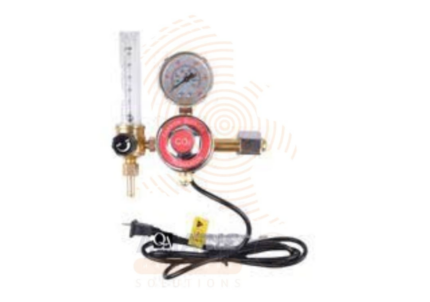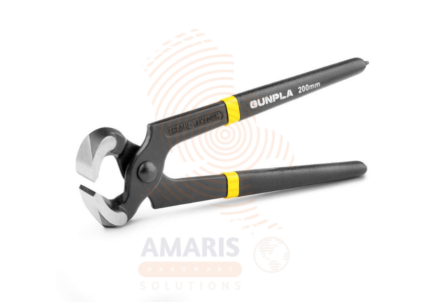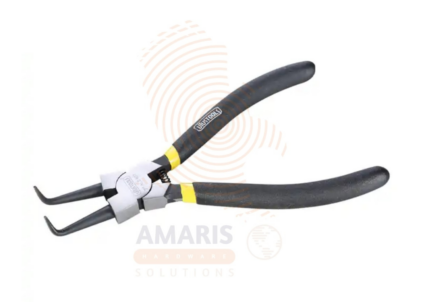
Regulator
$36.15 Original price was: $36.15.$34.34Current price is: $34.34.

Utility Knife with Three Blades
$14.58 Original price was: $14.58.$13.85Current price is: $13.85.
Utility Knife Blade (Trapeiod)
$12.46 Original price was: $12.46.$11.84Current price is: $11.84.
WhatsApp Order
A utility knife blade, often trapezoid in shape, is a cutting tool designed for versatile and precise cutting tasks. It typically features a sharp, pointed tip and straight edges, converging to form a trapezoidal profile. This design allows for easy maneuverability and access to tight spaces, making it suitable for various applications such as cutting paper, cardboard, plastic, and other lightweight materials. The trapezoid shape enhances stability and durability, providing a balance between sharpness and strength for efficient cutting in a wide range of tasks.
Description
Table of Contents
ToggleUtility Knife Blade (Trapeiod)
Uses
-
Cutting Paper and Cardboard:
-
Utility knife blades are frequently used for precision cutting of paper and cardboard, making them handy for tasks such as crafting, packaging, or office work.
-
-
Opening Boxes and Packages:
-
The sharp edge of a utility knife blade is well-suited for opening boxes and cutting through packaging materials, providing an efficient and controlled cutting experience.
-
-
Trimming and Shaping Materials:
-
These blades are useful for trimming and shaping various materials, including foam, rubber, and thin plastic. Their precision allows for detailed work in crafting and DIY projects.
-
-
Stripping Wires:
-
Electricians often use utility knife blades to strip insulation from wires, as the pointed tip and sharp edges make it easier to make precise cuts without damaging the underlying conductors.
-
-
Scoring and Marking:
-
Utility knife blades can be used for scoring materials like drywall, wood, or plastic, allowing for controlled and clean breaking or bending along the scored line.
-
-
Crafting and Hobbies:
-
Artists and hobbyists use utility knife blades for various tasks, including cutting mats, thin sheets of material, or intricate patterns in crafting projects.
-
-
Carving and Sculpting:
-
The sharp and controllable nature of these blades makes them suitable for carving and sculpting softer materials like clay or certain types of foam.
-
-
Precision Cutting in Construction:
-
Construction workers often use utility knife blades for precision cutting of materials like insulation, roofing materials, or other construction-related tasks.
-
-
Emergency Situations:
-
Utility knife blades can be valuable in emergency situations for cutting seatbelts, ropes, or other materials when a quick and precise cut is needed.
-
-
General Purpose Cutting:
-
The general-purpose nature of utility knife blades makes them handy for a wide range of cutting tasks around the home, workshop, or job site.
-
SAFETY HANDLING PRECAUTIONS
Safety Precautions
-
Use the Right Tool for the Task:
-
Ensure that you are using the appropriate utility knife blade for the specific task at hand. Different blades are designed for different materials and cutting purposes.
-
-
Wear Personal Protective Equipment (PPE):
-
Consider wearing safety gloves to protect your hands from accidental cuts. Safety glasses may also be necessary, especially when cutting materials that can produce debris.
-
-
Inspect the Blade:
-
Before use, inspect the blade for any signs of damage or wear. Replace the blade if it is dull, chipped, or damaged. A sharp blade is safer and more effective.
-
-
Secure the Material:
-
Make sure the material you are cutting is securely positioned and won't move unexpectedly. This helps maintain control over the cutting process and reduces the risk of slips or mishaps.
-
-
Keep Hands Away from the Cutting Path:
-
Position your hands away from the cutting path, especially the area directly behind the blade. This minimizes the risk of accidentally cutting yourself.
-
-
Cut Away from Your Body:
-
Always cut away from your body to avoid the knife slipping towards you. This helps prevent injuries in case of unexpected movement.
-
-
Maintain a Controlled Cutting Motion:
-
Use controlled and deliberate cutting motions, and avoid applying excessive force. Let the sharpness of the blade do the work.
-
-
Use a Cutting Surface:
-
Place a cutting surface, such as a self-healing mat or a stable workbench, underneath the material being cut. This protects the blade and provides a stable cutting surface.
-
-
Retract the Blade When Not in Use:
-
When the knife is not in use, retract the blade and engage any safety mechanisms to prevent accidental exposure. Many utility knives have a locking mechanism to keep the blade secure.
-
-
Store Safely:
-
When not in use, store the utility knife in a safe and designated location, away from the reach of children and others who may accidentally come into contact with it.
-
-
Take Breaks and Stay Alert:
-
Fatigue can lead to loss of concentration, increasing the risk of accidents. Take breaks when needed and stay focused on the task at hand.
-
-
Dispose of Blades Properly:
-
Discard used or broken blades in a designated blade disposal container. Do not leave them lying around where they can pose a risk.
-
Related products
Bi-Metal Hole Saw Set
A Bi-Metal Hole Saw Set refers to a collection of nine hole saws, each constructed with a bi-metal design. A hole saw is a cylindrical cutting tool used to create holes in various materials such as wood, metal, plastic, and more. The term "bi-metal" indicates that the hole saws are made from two different types of metals, typically high-speed steel (HSS) and a more durable alloy like cobalt. This combination enhances the hole saw's cutting performance, making it suitable for a wide range of applications and providing increased durability and longevity. The set typically includes hole saws of different sizes to accommodate various hole diameters, making it a versatile tool for professionals and DIY enthusiasts alike.
Bodywork Tool Set
A Bodywork Tool Set typically refers to a collection of seven specialized tools designed for use in automotive body repair and restoration. These tools are specifically crafted to assist in shaping, smoothing, and repairing the body panels of vehicles, addressing issues such as dents, dings, and other imperfections. The set may include various tools such as hammers, dollies, and other shaping implements, each serving a specific purpose in the process of restoring or enhancing the appearance of a vehicle's bodywork. These tool sets are commonly used by auto body technicians, mechanics, or individuals involved in automotive restoration projects.
Carpenter’s Pencil – Hexagon
A Carpenter's Pencil Hexagon refers to a pencil specifically designed for carpentry work, characterized by its hexagonal shape. Unlike traditional round pencils, the hexagonal shape of a Carpenter's Pencil prevents it from rolling off surfaces and provides a more secure grip, making it practical for precision and control in carpentry tasks. The design also allows for easy identification and retrieval among other tools on a busy work site. Additionally, Carpenter's Pencils often feature a flat or rectangular cross-section, further preventing them from rolling and making them convenient for marking lines with straight edges.
Carpenter’s Pincers
Carpenter's pincers, also known as end-cutting pliers or end nippers, are a type of hand tool used in carpentry and woodworking. They typically have sharp, pointed jaws that come together in a cutting edge at the tips. These pincers are designed for gripping, cutting, and pulling materials such as nails, wires, or small objects in woodworking applications. The jaws are angled to provide leverage and facilitate precise cutting or gripping in tight spaces. Carpenter's pincers are a versatile tool commonly found in a carpenter's toolkit for various tasks related to shaping and assembling wood.
Combination spanner set
A combination spanner set typically refers to a collection of twelve different-sized spanners that feature both open-end and box-end configurations. Combination spanners are versatile tools commonly used in mechanical and household applications. The open end is designed to grip fasteners in tight spaces, while the box end provides a more secure grip on the flats of a nut or bolt.
The set usually includes a range of sizes to accommodate various fastener dimensions. Each spanner in the set may be marked with its specific size, typically in metric or imperial units. This versatile tool set is essential for tasks that require tightening or loosening nuts and bolts in different applications, providing flexibility and convenience for the user.
Die Set
An Die Set typically refers to an 8-piece die set used in various manufacturing and machining processes. In manufacturing and metalworking, dies are specialized tools used to shape, cut, or form materials such as metal, plastic, or other substances. A die set, in this context, is a collection of individual dies designed to work together for specific tasks.
Double – End Bits Set
A Double - End Bits Set typically refers to a collection of interchangeable tool bits designed for use with screwdrivers, power drills, or similar tools. Each bit in the set has two distinct ends with different types or sizes of tips, allowing the user to perform various tasks without needing multiple individual bits. These sets often include a variety of common bit types, such as Phillips, slotted, Torx, or hex, providing versatility for different screw and fastener types. The double-ended design allows users to flip the bit and switch between different tips easily, making it a convenient and space-saving solution for various applications.
External Circlip Pliers Bent
External circlip pliers – bent refer to a specialized hand tool designed for the installation and removal of external circlips. A circlip, also known as a retaining ring or snap ring, is a type of fastener or retaining device that fits into a groove on a cylindrical object, such as a shaft or a bore. External circlips are positioned on the outside of the shaft or bore.
The term "bent" in the context of external circlip pliers describes the shape of the tool. These pliers typically have angled or bent tips that allow for easier access to the external circlip, especially in tight or confined spaces. The bent design helps the user reach and manipulate the circlip more effectively, providing improved maneuverability during installation or removal.


 Acrylic Sealants
Acrylic Sealants Construction Adhesives
Construction Adhesives Double-Sided Tape
Double-Sided Tape Duct Tape
Duct Tape Electrical Tape
Electrical Tape Epoxy & Resins
Epoxy & Resins Masking Tape
Masking Tape
 Automotive Wrenches & Socket Sets
Automotive Wrenches & Socket Sets Battery Chargers & Jump Starters
Battery Chargers & Jump Starters Car Jacks & Stands
Car Jacks & Stands Car Wash & Detailing Products
Car Wash & Detailing Products Diagnostic Tools
Diagnostic Tools Tire Inflators
Tire Inflators Vehicle Lighting
Vehicle Lighting Oil & Lubricants
Oil & Lubricants
 Adhesives & Sealants
Adhesives & Sealants Bricks & Blocks
Bricks & Blocks Cement & Concrete
Cement & Concrete Drywall & Plaster
Drywall & Plaster Flooring (Tiles, Wood, Laminate)
Flooring (Tiles, Wood, Laminate) Lumber & Plywood
Lumber & Plywood Paints, Primers & Coatings
Paints, Primers & Coatings Insulation Materials
Insulation Materials Roofing Materials
Roofing Materials
 Circuit Breakers
Circuit Breakers Electrical Cables & Wires
Electrical Cables & Wires Switches & Sockets
Switches & Sockets Fuses & Relays
Fuses & Relays Connectors & Terminals
Connectors & Terminals Electrical Boxes & Panels
Electrical Boxes & Panels Conduit & Fittings
Conduit & Fittings Lighting Fixtures & Bulbs
Lighting Fixtures & Bulbs Extension Cords & Power Strips
Extension Cords & Power Strips
 Anchors
Anchors Bolts
Bolts Clips & Clamps
Clips & Clamps Screws
Screws Nuts
Nuts Washers
Washers Rivets
Rivets Nails
Nails Threaded Rods
Threaded Rods
 Hammers
Hammers Measuring Tools (Tapes, Levels, Calipers)
Measuring Tools (Tapes, Levels, Calipers) Screwdrivers
Screwdrivers Pliers & Cutters
Pliers & Cutters Saws & Blades
Saws & Blades Chisels & Punches
Chisels & Punches Allen Keys & Hex Keys
Allen Keys & Hex Keys Ratchets & Socket Sets
Ratchets & Socket Sets Wrenches & Spanners
Wrenches & Spanners
 Power Tool Accessories (Blades, Bits, Discs)
Power Tool Accessories (Blades, Bits, Discs) Rotary Tools
Rotary Tools Saws (Circular, Jigsaw, Reciprocating)
Saws (Circular, Jigsaw, Reciprocating) Drills & Drivers
Drills & Drivers Grinders & Sanders
Grinders & Sanders Heat Guns
Heat Guns Nail Guns
Nail Guns Impact Wrenches
Impact Wrenches Batteries & Chargers
Batteries & Chargers
 Pipes & Fittings (PVC, Copper, PEX)
Pipes & Fittings (PVC, Copper, PEX) Plumbing Tools
Plumbing Tools Pumps & Motors
Pumps & Motors Sealants & Adhesives for Plumbing
Sealants & Adhesives for Plumbing Valves & Taps
Valves & Taps Water Heaters
Water Heaters Drainage Systems
Drainage Systems Faucets & Fixtures
Faucets & Fixtures Hoses & Tubing
Hoses & Tubing
 Hinges & Latches
Hinges & Latches Hooks & Brackets
Hooks & Brackets Window Hardware
Window Hardware Chains & Cables
Chains & Cables Casters & Wheels
Casters & Wheels Shelving & Storage Systems
Shelving & Storage Systems Door Handles & Locks
Door Handles & Locks Drawer Slides & Cabinet Hardware
Drawer Slides & Cabinet Hardware
 Personal Protective Equipment (PPE)
Personal Protective Equipment (PPE) Respirators & Masks
Respirators & Masks Safety Glasses
Safety Glasses Safes
Safes Security Cameras
Security Cameras Gloves
Gloves Helmets
Helmets Ear Protection
Ear Protection Fire Safety Equipment
Fire Safety Equipment Locks & Padlocks
Locks & Padlocks Motion Sensors & Alarms
Motion Sensors & Alarms
 Garden Fencing
Garden Fencing Garden Furniture Hardware
Garden Furniture Hardware Lawn Mowers
Lawn Mowers Trimmers & Edgers
Trimmers & Edgers Shovels & Spades
Shovels & Spades Rakes & Hoes
Rakes & Hoes Pruning Shears & Loppers
Pruning Shears & Loppers Watering Systems (Hoses, Sprinklers, Nozzles)
Watering Systems (Hoses, Sprinklers, Nozzles)
 Interior Paints
Interior Paints Paint Brushes & Rollers
Paint Brushes & Rollers Paint Strippers & Thinners
Paint Strippers & Thinners Paint Trays & Accessories
Paint Trays & Accessories Exterior Paints
Exterior Paints Spray Paints
Spray Paints Primers & Undercoats
Primers & Undercoats Varnishes & Stains
Varnishes & Stains
 Gaskets & Seals
Gaskets & Seals Hydraulic Fittings
Hydraulic Fittings Industrial Fasteners
Industrial Fasteners Industrial Hoses
Industrial Hoses Lubricants & Greases
Lubricants & Greases Metal Sheets & Bars
Metal Sheets & Bars Bearings & Bushings
Bearings & Bushings Belts & Pulleys
Belts & Pulleys
 HVAC Filters
HVAC Filters Insulation for HVAC
Insulation for HVAC Air Conditioners
Air Conditioners Refrigerants
Refrigerants Ventilation Ducts & Fittings
Ventilation Ducts & Fittings Thermostats & Controllers
Thermostats & Controllers Fans & Blowers
Fans & Blowers
 Pegboards & Hooks
Pegboards & Hooks Shelving Units
Shelving Units Storage Bins & Containers
Storage Bins & Containers Toolboxes & Tool Chests
Toolboxes & Tool Chests Workbenches
Workbenches Drawer Organizers
Drawer Organizers Labeling Supplies
Labeling Supplies
 Welding Accessories (Clamps, Brushes)
Welding Accessories (Clamps, Brushes) Welding Electrodes & Rods
Welding Electrodes & Rods Welding Helmets & Gloves
Welding Helmets & Gloves Welding Machines
Welding Machines Soldering Irons & Stations
Soldering Irons & Stations Flux & Solder Wire
Flux & Solder Wire
 Generator Accessories
Generator Accessories Inverters
Inverters Portable Generators
Portable Generators Power Inverters
Power Inverters Transfer Switches
Transfer Switches Diesel & Gasoline Generators
Diesel & Gasoline Generators
 Transport Equipment: Carts, Dollies, and Hand Trucks
Transport Equipment: Carts, Dollies, and Hand Trucks Storage Solutions: Pallets, Racks, and Containers
Storage Solutions: Pallets, Racks, and Containers Lifting Equipment: Hoists, Cranes, and Jacks
Lifting Equipment: Hoists, Cranes, and Jacks Conveyors and Accessories: Belts and Rollers
Conveyors and Accessories: Belts and Rollers











